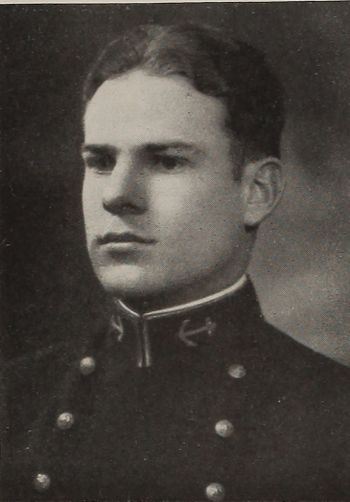LAWRENCE C. BRUNTON, 2LT, USMC
Lawrence Brunton '30
Lucky Bag
From the 1930 Lucky Bag:
LAWRENCE COLLINS BRUNTON
Mountain View, California
"Phoebe" "Larry"
FROM California, from die glory of the sunset, he has come to us. With a spirit of adventure and romance strong in him, he turned to the sea. And with the desire to command, he aspired to a commission. He had difficulty in getting his appointment, but since then he has found it no bed of roses.
Plebe year he nearly lost both rounds with the Academic Departments, but fought it out and beat them for a chance at Youngster Year. Since then he has never been unsat badly, but it is doubtful if he ever studies. Not wooden, of course, but there are far too many pleasures in life to let the 'Acs" bother him much.
Phoebe is too small to be a more famous athlete but he can play tennis and the banjo, especially in the latter, as witness the fact of his position in the "N. A. Ten." Phoebe's whole life is his music, for his banjo was going, even along with the "vic," any time of night or day, study hour, or otherwise. What that boy can't do with his banjo isn't worth doing; he can make it talk, cry or laugh, even as he wants you to do and you can't help yourself.
Phoebe has played his way into our hearts and we expect to hear some more of that banjo in some J.O. mess when, after the rigors of some four hours on the bridge. Phoebe will relax our souls and lull us to dreamland.
Mandolin Club 3, 2, 1, Leader 1; N. A. "10" 3, 2, 1; 2 P.O.

LAWRENCE COLLINS BRUNTON
Mountain View, California
"Phoebe" "Larry"
FROM California, from die glory of the sunset, he has come to us. With a spirit of adventure and romance strong in him, he turned to the sea. And with the desire to command, he aspired to a commission. He had difficulty in getting his appointment, but since then he has found it no bed of roses.
Plebe year he nearly lost both rounds with the Academic Departments, but fought it out and beat them for a chance at Youngster Year. Since then he has never been unsat badly, but it is doubtful if he ever studies. Not wooden, of course, but there are far too many pleasures in life to let the 'Acs" bother him much.
Phoebe is too small to be a more famous athlete but he can play tennis and the banjo, especially in the latter, as witness the fact of his position in the "N. A. Ten." Phoebe's whole life is his music, for his banjo was going, even along with the "vic," any time of night or day, study hour, or otherwise. What that boy can't do with his banjo isn't worth doing; he can make it talk, cry or laugh, even as he wants you to do and you can't help yourself.
Phoebe has played his way into our hearts and we expect to hear some more of that banjo in some J.O. mess when, after the rigors of some four hours on the bridge. Phoebe will relax our souls and lull us to dreamland.
Mandolin Club 3, 2, 1, Leader 1; N. A. "10" 3, 2, 1; 2 P.O.
Loss
From Find A Grave:
Lawrence Collins Brunton was the son of Delbert Brunton and Julia Lossing. He was a graduate of the Naval Academy in the Class of 1930. On June 5, 1930, Lieutenant Brunton married Alice Bender.
While serving in Nicaragua [on April 21, 1932], a Guardia patrol was ambushed as it crossed a small stream. Lieutenant Brunton was the commander of a relief column that had been sent to assist. After the two columns met up, they were ambushed along the road. Lieutenant Brunton was one of three men killed. He had been in country less than one month.
There are a few other details in this report (page 8).
A report from the June 1932 issue of Leatherneck indicates he detached from MCB San Diego, California on March 2, 1932, and that he wasn't schedule to sail for Nicaragua until the 18th.
Other Information
From researcher Kathy Franz:
On June 5, 1924, two packing houses were destroyed by fire in Fresno. Lawrence, Senior Patrol leader of Troop 12, was at a meeting in the American Legion Hall. His troop joined 100 other scouts undergoing tests for merit badges at city hall, and they stretched ropes around the area to stop the rush of people to the fire area.
As a junior at Fresno High School, Lawrence and his older brother Charles both enlisted in the navy in July, 1924. At first apprentice seamen, they were aided in their studies for Annapolis by the regular seaman’s preparatory course offered sailors between the ages of 17 and 20. While attending the naval academy they were paid $780 a year. Charles graduated from the Naval Academy with the Class of 1929.
From the Fresno, Bee, May 16, 1925: Lawrence came from the Panama Canal to play in the national championship tennis matches at Annapolis. He was one of the winners of doubles matches played in San Diego recently. After the Annapolis tournament he expects to be assigned to a ship of the Atlantic fleet.
Lawrence visited his home in March 1932 on his way to Nicaragua. Per The Fresno Bee, April 22: “Lieutenant Brunton knew of the dangers he faced in the bandit-ridden Nicaraguan country when he was in Fresno. Mrs. Barnett [his sister] said while he declined to discuss his assignment to the dangerous country, his manner while here indicated to her that he did not want his family to be apprehensive, although he knew of the possibility of death.”
His sisters were Alberta (Mrs. O. R. Barnett) and Lucille (Mrs. Charles Emerson Boyle.) Their youngest brother was Thomas.
Their father was a captain in World War I. He spoke in April 1919 about going overseas with the Fortieth Division from New York. Per the Santa Ana Register, April 23, 1919: He was in command of Company C, ammunition train, and with his company was under fire the first time from Sept. 23 to Oct. 10, in the Argonne. . . . His work was mostly in commanding companies in charge of ammunition dumps . . .[ but was temporarily assigned to policing the battlefields] . . . Bodies were picked up on stretchers and carried sometimes two and three miles to burial trenches. The trenches were about six feet deep and as many wide and the bodies were stacked in with the head of one body at the feet of the next – the trenches were just as long as was necessary. He said, “We found just twice as many Americans as Germans.”
Lawrence was survived by his wife and is buried in Arlington National Cemetery.
Photographs
The "Register of Commissioned and Warrant Officers of the United States Navy and Marine Corps" was published annually from 1815 through at least the 1970s; it provided rank, command or station, and occasionally billet until the beginning of World War II when command/station was no longer included. Scanned copies were reviewed and data entered from the mid-1840s through 1922, when more-frequent Navy Directories were available.
The Navy Directory was a publication that provided information on the command, billet, and rank of every active and retired naval officer. Single editions have been found online from January 1915 and March 1918, and then from three to six editions per year from 1923 through 1940; the final edition is from April 1941.
The entries in both series of documents are sometimes cryptic and confusing. They are often inconsistent, even within an edition, with the name of commands; this is especially true for aviation squadrons in the 1920s and early 1930s.
Alumni listed at the same command may or may not have had significant interactions; they could have shared a stateroom or workspace, stood many hours of watch together… or, especially at the larger commands, they might not have known each other at all. The information provides the opportunity to draw connections that are otherwise invisible, though, and gives a fuller view of the professional experiences of these alumni in Memorial Hall.
October 1930
January 1931
April 1931
July 1931
October 1931
January 1932
April 1932
Lawrence is one of 42 members of the Class of 1930 on Virtual Memorial Hall.

The "category" links below lead to lists of related Honorees; use them to explore further the service and sacrifice of alumni in Memorial Hall.
